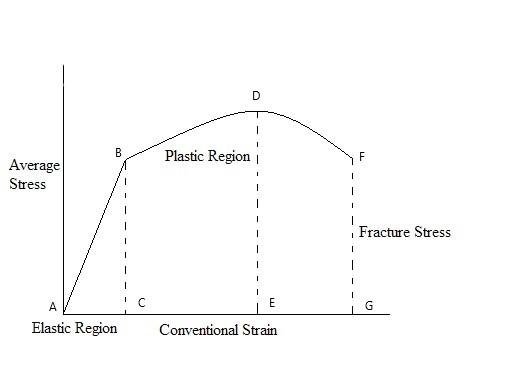
What is the type of deformation in plastic deformation?
A) Reversible
B) Permanent
C) Both
D) None
Answer
216.3k+ views
Hint:The deformation in the elastic region is reversible as the material goes back to its original shape and size on the removal of stress.
Complete step by step solution:

The above stress-strain curve is for a ductile material. In the given stress-strain curve, the part ABC represents the elastic region whereas the part BDFGEC represents the plastic region.
The point B is also known as the elastic limit or proportional limit. Point C on the x-axis represents the strain when stress corresponding to point B is applied on the material.
When stress greater than the elastic limit is applied, the material does not regain its original shape and size even after the removal of the applied stress. After the removal of stress greater than elastic limit, only elastic strain is recovered, the plastic strain remains. This strain that remains is known as a permanent set. It is not recoverable.
In brittle materials, the plastic region is smaller and the material cannot bear a stress much larger than the elastic limit of the material. However, the deformation in the plastic region of brittle materials is also non-recoverable.
Hence, plastic deformation in both brittle and ductile materials is permanent and irreversible.
Therefore, option B is the correct answer for this question.
Note: Deformation is the change in shape or size of an object. It is not the same as strain. Strain is change in dimension per unit dimension of the material or deformation per unit dimension. Deformation has the dimension of length whereas strain is dimensionless.
Complete step by step solution:

The above stress-strain curve is for a ductile material. In the given stress-strain curve, the part ABC represents the elastic region whereas the part BDFGEC represents the plastic region.
The point B is also known as the elastic limit or proportional limit. Point C on the x-axis represents the strain when stress corresponding to point B is applied on the material.
When stress greater than the elastic limit is applied, the material does not regain its original shape and size even after the removal of the applied stress. After the removal of stress greater than elastic limit, only elastic strain is recovered, the plastic strain remains. This strain that remains is known as a permanent set. It is not recoverable.
In brittle materials, the plastic region is smaller and the material cannot bear a stress much larger than the elastic limit of the material. However, the deformation in the plastic region of brittle materials is also non-recoverable.
Hence, plastic deformation in both brittle and ductile materials is permanent and irreversible.
Therefore, option B is the correct answer for this question.
Note: Deformation is the change in shape or size of an object. It is not the same as strain. Strain is change in dimension per unit dimension of the material or deformation per unit dimension. Deformation has the dimension of length whereas strain is dimensionless.
Recently Updated Pages
JEE Atomic Structure and Chemical Bonding important Concepts and Tips

JEE Amino Acids and Peptides Important Concepts and Tips for Exam Preparation

Electricity and Magnetism Explained: Key Concepts & Applications

Chemical Properties of Hydrogen - Important Concepts for JEE Exam Preparation

JEE Energetics Important Concepts and Tips for Exam Preparation

JEE Isolation, Preparation and Properties of Non-metals Important Concepts and Tips for Exam Preparation

Trending doubts
JEE Main 2026: Application Form Open, Exam Dates, Syllabus, Eligibility & Question Papers

Derivation of Equation of Trajectory Explained for Students

Hybridisation in Chemistry – Concept, Types & Applications

Understanding the Angle of Deviation in a Prism

Understanding Collisions: Types and Examples for Students

How to Convert a Galvanometer into an Ammeter or Voltmeter

Other Pages
JEE Advanced Marks vs Ranks 2025: Understanding Category-wise Qualifying Marks and Previous Year Cut-offs

Units And Measurements Class 11 Physics Chapter 1 CBSE Notes - 2025-26

NCERT Solutions For Class 11 Physics Chapter 8 Mechanical Properties Of Solids

Motion in a Straight Line Class 11 Physics Chapter 2 CBSE Notes - 2025-26

NCERT Solutions for Class 11 Physics Chapter 7 Gravitation 2025-26

Ideal and Non-Ideal Solutions Explained for Class 12 Chemistry




